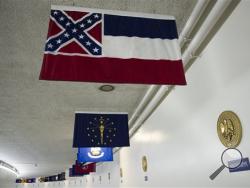ATLANTA (AP) — South Carolina Gov. Nikki Haley called for removing the Confederate battle flag that flies in front of her state's Capitol. But she hasn't said the Confederate veterans' monument alongside the flag should go.
Nor has she called for moving a nearby statue of Benjamin Tillman, an unapologetic white supremacist who served as governor and U.S. senator during the early decades of Jim Crow segregation.
Alabama Gov. Robert Bentley hasn't said anything definitive this week about the 88-foot-tall Confederate monument — complete with four Confederate banners — that sits outside his office.
Georgia Gov. Nathan Deal says his state will redesign a vanity license plate that features the battle flag. But the Capitol complex where he works is replete with portraits, statues and busts of Confederate figures and subsequent segregationist leaders.
That's all part of a complicated reality across the Old Confederacy: State-sponsored tributes to the Southern rebellion go well beyond the familiar star-studded 'X' overlaying a field of red. And they aren't likely to disappear anytime soon, even amid the renewed attention to the battle flag after Dylann Roof, the suspect in the fatal shooting of nine parishioners at a historic black church, is seen in photographs brandishing it as a symbol of hate.
"It's a very delicate subject here," said historian Stan Deaton of the Georgia Historical Society. "Let's not kid ourselves: So much of it has to do with race. ... People will say, 'It's our history,' but really most of it was placed by particular groups ... to present a very selective interpretation of what the Confederacy and the (Old) South were."
Many statehouse grounds around the region include at least one Confederate monument, along with imposing statues of Southern war heroes. So does Arlington National Cemetery, built on land once owned by Confederate Gen. Robert E. Lee.
Same goes for dozens of courthouses, more than a few in counties named for figures including Lee, Confederate President Jefferson Davis and Gen. Nathan Bedford Forrest, an early Ku Klux Klan leader. Forrest has a bust at the Tennessee Capitol, though Gov. Bill Haslam endorsed its removal Tuesday.
Two public high schools near the Alabama Capitol are named for Lee and Davis; both campuses now serve almost exclusively black student bodies. Lee, Davis and other Old South luminaries have their names emblazoned on streets: Emanuel African Methodist Episcopal Church, site of the massacre in Charleston, is on Calhoun Street, named for John C. Calhoun, pre-Civil War slavery defender and secession advocate.
Several Southern states recognize Lee's and Davis' birthdays. In a few, Lee's is recognized on the same day as the federal holiday honoring slain civil rights leader Martin Luther King Jr.
In Kentucky, a border state during the Civil War, a Davis statue stands in the Capitol rotunda, positioned so that the Confederacy's only president appears to be looking over the shoulder of Abraham Lincoln, the 16th U.S. president whose statue stands in the rotunda's center.
Many of the commemorations were established in the early decades of Jim Crow segregation at the behest of groups such as the United Daughters of the Confederacy, Sons of Confederate Veterans and their forerunners.
Confederate heritage leaders say political leaders' statements this week worry them.
"First it's the flags, then the monuments, then the streets' names, then the holidays. I feel like it's open season on anything Confederate," said Kelly Barrow, commander in chief of the Sons of Confederate Veterans. Barrow says his organization shouldn't be tainted by Roof's actions and apparent racist philosophy.
The Sons organization calls the Civil War "the second American revolution." The United Daughters of the Confederacy states in one of its creeds that "the War Between the States was not a rebellion, nor was its underlying cause to sustain slavery."
Deaton, the Georgia historian, said those views, often reflected in the monuments, are part of how elected officials avoid potential controversies over the displays. He called it "the lost-cause narrative" that obscures the reasons for secession that Southern leaders plainly stated at the time.
"The monuments are never about slavery. They're never about treason," Deaton said. "They're always about noble virtues like honor and valor. They didn't have a problem acknowledging the reasons for the war in 1861. Their descendants have a problem with it today."
There is precedent for curtailing some of the tributes, but even some of those cases highlight the ubiquitous reach of Old South history.
Officials at the University of Mississippi, whose athletics teams are known as the "Ole Miss Rebels," retired its costumed mascot "Colonel Reb" in 2010, replacing him with a "Rebel Black Bear." But the school band still plays the Old South anthem "Dixie."
In South Carolina, the battle flag flies where it is only as a compromise that removed it from atop the Capitol dome in 2000. A few years later, Georgia officials boasted that they moved past the battle flag by redesigning their state banner. But the new version was a compromise patterned after the first national flag of the Confederacy, known as the "Stars and Bars."
And in 2013, Deal, the Georgia governor, authorized the relocation of a statute of Tom Watson, a white supremacist politician whose likeness had sat near a Capitol entrance since 1932. But Deal said at the time the move was to accommodate a renovation project.
The Watson statue now stands across the street, in "Talmadge Plaza," named for a 20th century Georgia governor who defended segregation.
___
The writer is not related to the Sons of Confederate Veterans representative. Follow Bill Barrow on Twitter at https://www.twitter.com/BillBarrowAP .

